Are PLA anti-tank weapons capable of fighting modern armored vehicles?
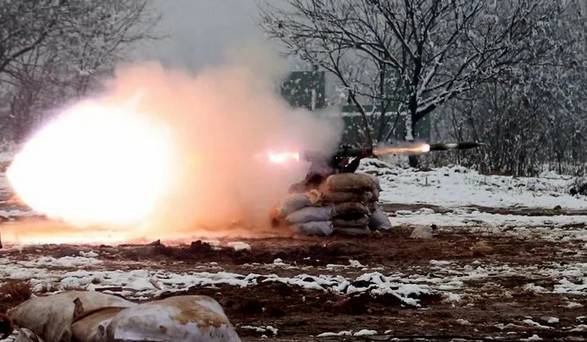
At the end of the 20th century, the Chinese infantry had anti-tank weapons that could successfully counter tanks the first post-war generation not equipped with dynamic protection. The Chinese hand and rocket-propelled grenades were quite able to penetrate the armor of the Soviet T-55 and T-62 or the American M48 and M60 in favorable conditions. Under the conditions that developed between the mid-1970s and the early 1990s, the low efficiency of the Chinese infantry weapons against modern tanks with multi-layered reservations was not critical. In the Soviet divisions deployed on the Soviet-Chinese and Sino-Mongolian borders, the bulk of the tanks were built in the 1950s and 1960s, and the modern T-64, T-72 and T-80 were mainly in the European part of the country and in groups Soviet troops stationed in the GDR and Czechoslovakia. The same can be said of other countries with which China could enter into an armed conflict on land. Indian armored forces in the 1960-1980s were equipped with British Centurion tanks and Soviet T-55s, in Vietnam the Soviet T-34-85, T-54, T-55 and captured American M48A3 were in service.
At the beginning of the 21st century, the PLA introduced a light anti-tank weapon capable of overcoming the armor of such vehicles as the T-72, T-80 or M1 Abrams. First of all, the PLA command was interested in modern disposable anti-tank grenade launchers suitable for arming individual soldiers with them. Since the second half of the 1980s, the issue of replacing hand-held cumulative grenades, which at that time were an outright anachronism, was an acute issue. After adopting the Type 3 hand-held anti-tank grenade and failures with the Type 70 grenade launcher, specialists at the Norinco Chinese weapons company began developing a one-time 80 mm grenade launcher. Weapon tests began in the late 1980s, and in 1993 the first batch of grenade launchers entered the army.
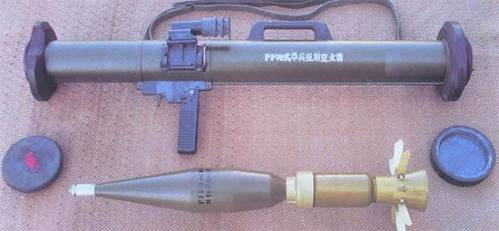
A fiberglass container is used to transport and launch a rocket-propelled grenade. It is closed on both sides with rubber covers that prevent foreign objects from getting inside, and also fix the grenade. In the upper part of the grenade launcher there is a carrying handle, on the left side there is a primitive optical sight, a belt is fastened on the right side, and a trigger mechanism is assembled at the bottom. The pistol grip is rotatable, in a combat position it cockes the trigger mechanism and releases the trigger. A rocket-propelled grenade with a cumulative warhead is equipped with a piezoelectric fuse; after exiting the launch container, it stabilizes on the trajectory with eight folding blades.
The weight of the equipped grenade launcher is 3,7 kg, length - 900 mm. It is stated that an 80-mm grenade weighing 1,84 kg is capable of breaking through a homogeneous armor with a thickness of more than 400 mm. The initial speed of the grenade is 147 m / s. Effective firing range - no more than 250 m. Maximum sighting range - 400 m.
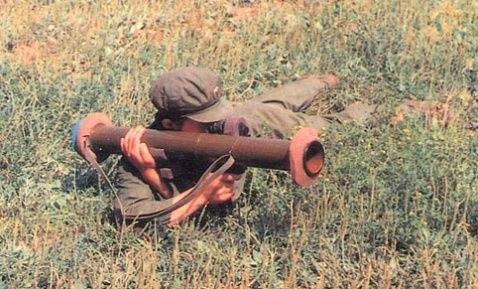
The PF-89 grenade launcher was originally created to combat armored targets, but can also be used to destroy shelters, destroy firing points and enemy manpower. In terms of capabilities, this weapon is comparable to the later modifications of the American disposable grenade launcher M72 LAW or the Soviet RPG-26 grenade launcher.
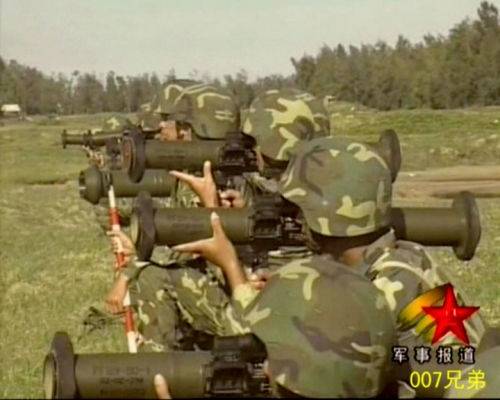
After the start of mass deliveries of the PF-89, the Chinese military leadership found it possible to abandon the Type 69 grenade launchers (Chinese copy of the RPG-7) in “quick response” units.
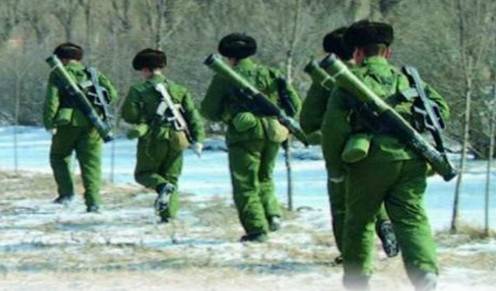
The number of disposable grenade launchers distributed between fighters of an infantry platoon must be at least ten. A plus of this approach is an increase in the firepower of the platoon as a whole, since a larger number of fighters are equipped with full-time automatic weapons, and in the event of a collision with enemy armored vehicles, it can be simultaneously fired from a larger number of anti-tank grenade launchers. Grenade launchers PF-89 in addition to the PLA are in service in the army of Cambodia. This weapon proved to be quite good during the civil war in Libya.
In connection with the active equipment of armored vehicles with dynamic protection elements and the need to increase capabilities in terms of combating manpower and destroying field fortifications, modifications of a grenade launcher with a tandem and cumulative-fragmentation grenade appeared in the 21st century.
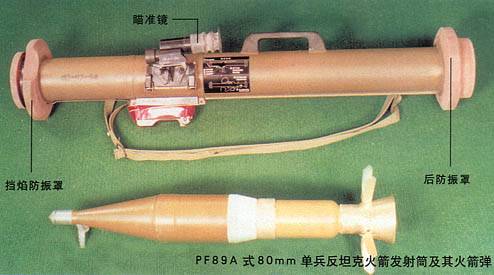
The PF-89A grenade launcher is equipped with a fragmentation-cumulative grenade, having 200 mm armor penetration normal. But at the same time, the fragmentation and high-explosive effect is significantly increased, which allows the use of a grenade launcher as an assault weapon. According to Chinese sources, an adaptive fuse is used for the PF-89A grenade, which allows you to go deep into soft obstacles (sandbags or earthy parapet) or to break through unstable obstacles (thin walls or window panes) without undermining the charge. This makes it possible to effectively defeat enemy manpower, which is in light shelters.
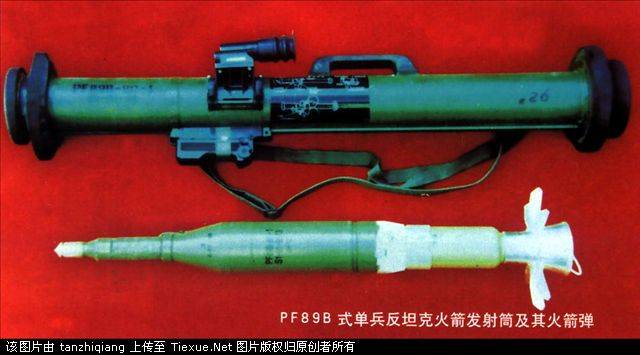
For the PF-89B grenade launcher, a tandem cumulative grenade was created, designed to combat tanks that have dynamic protection ("reactive armor"). It is stated that the armor penetration of the PF-89B after overcoming dynamic protection when hit at a right angle is more than 600 mm. However, taking into account the caliber and dimensions of the Chinese tandem grenade and the comparative characteristics of modern Russian anti-tank grenades, the declared armor penetration of the Chinese PF-89B grenade launcher seems to be overestimated.
Another type of disposable grenade launcher used by the PLA is the DZJ-08. He entered service with the Chinese infantry in 2008. The main purpose of the DZJ-08 is the destruction of field fortifications, but in addition to this, the grenade launcher can be successfully used to combat machines protected by armor up to 100 mm thick. The DZJ-08 grenade launcher has a mass of 7,6 kg and a length of 971 mm. The initial speed of a grenade weighing 1,67 kg is 172 m / s. Sighting range - up to 300 m.
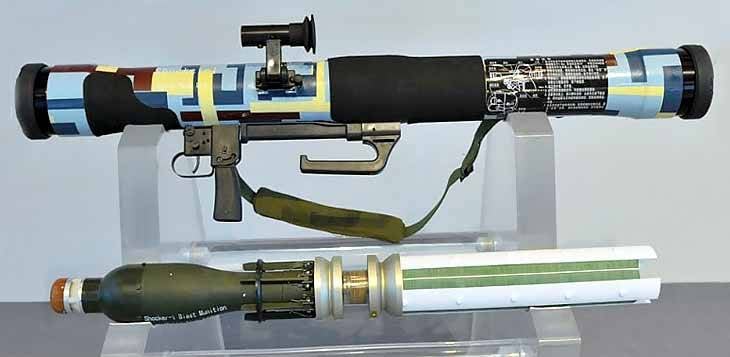
In the explosion of an 80-mm high-explosive cumulative-high-explosive grenade, the expansion of slaughter splinters does not exceed 7 m, which facilitates its use by assault units. The DZJ-08 grenade launcher provides guaranteed penetration of a concrete wall up to 500 mm thick. For safe shooting in confined spaces, a counter-mass is used in the grenade launcher, which compensates for recoil and reduces the impact of a jet stream. For a safe start, a room with dimensions of 2,5x2,5x2,5 m is required, which makes the grenade launcher convenient for fights in urban conditions. Cocking a grenade fuse occurs 10 m after departure from the barrel, but the minimum safe firing distance is at least 25 m.
When fired from a DZJ-08, an interesting visual effect is observed - the photograph shows that the hot powder gases shine through the fiberglass barrel.
The relative weakness of the 80-mm cumulative grenades caused the creation of a 120-mm PF-98 grenade launcher in China. Serial production of these weapons began in 1999, and currently the PF-98 displaced Type 69 grenade launchers and Type 80 recoilless guns in parts of the first line. At the beginning of the 78st century, 21-mm PF-120 grenade launchers in anti-tank platoons of the battalion unit were finally replaced 98-mm recoilless Type 105 guns mounted on Beijing BJ75S jeeps.
The PF-98 grenade launcher is designed for use in battalion and company units. The body weight of a grenade launcher is about 10 kg. Mass in combat position - 29 kg. The length of the weapon is 1191 mm. A fiberglass barrel has a resource of at least 200 shots. Combat rate of fire - up to 6 rounds / min. The calculation is 3 people, if necessary, one soldier can service the gun, but the rate of fire in this case is reduced to 2 rounds / min.
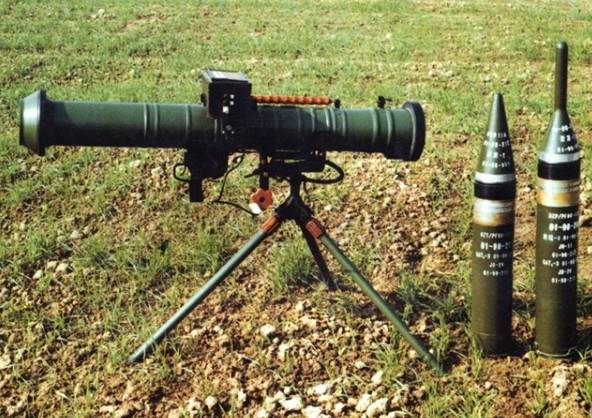
Grenade launchers used as a battalion anti-tank weapons are equipped with a laser rangefinder and ballistic computer, the information from which is displayed on a small display. To aim at the target, an optical 4-fold sight with a night channel is used, which ensures detection of the tank in the dark at a distance of 500 m.
Company-level grenade launchers are equipped with night optics with a range of 300 m, but are devoid of a ballistic computer and a laser rangefinder. The guns used as a battalion anti-tank weapons are mounted on a tripod machine, and from the company grenade launchers firing from the shoulder. For better stability, the front support is usually used.
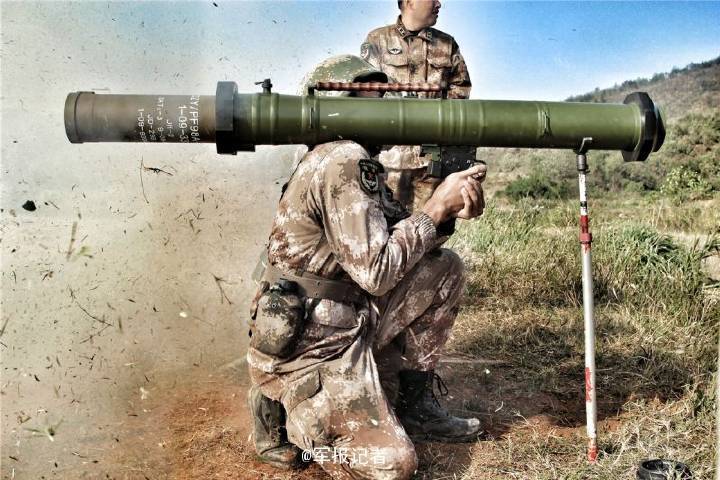
Shooting is carried out by cumulative tandem and universal cumulative-fragmentation shots. According to information published in Chinese sources, a tandem cumulative grenade weighing 7,5 kg leaves the barrel at a speed of 310 m / s and has an impact range of up to 800 m (effective range of not more than 400 m). After overcoming dynamic protection, it is capable of breaking through 800 mm homogeneous armor in a normal way. Cumulative-fragmentation grenade weighing 6,3 kg, has a range of fire on area targets up to 2000 m. The universal grenade is equipped with steel balls, which ensures the defeat of manpower within a radius of 25 from the rupture point. When meeting armor at a right angle, a cumulative-fragmentation grenade is capable of penetrating 400 mm homogeneous armor. In 2018, mass deliveries of lightweight 120-mm PF-98A grenade launchers began. According to information provided by the PLA, the new grenade launcher has a length of 1250 mm, a weight of about 7 kg and uses ammunition from the early model.
Talking about the Chinese infantry anti-tank weapons, it would be wrong not to mention the automatic grenade launchers, in the ammunition of which there are shots with cumulative grenades.
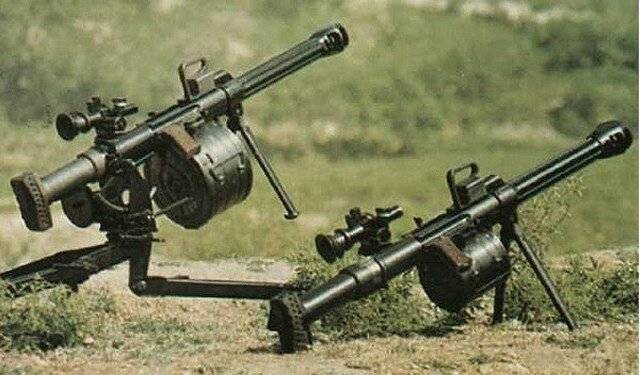
The first Chinese automatic grenade launcher was the 35 mm QLZ-87. In the 1970-1980s, the Chinese managed to get acquainted with the American 40-mm grenade launchers Mk 19 and the Soviet 30-mm AGS-17. In the late 1980s, Chinese experts, who had their own view on weapons of this kind, preferred to create a model, albeit inferior to easel automatic grenade launchers in practical rate of fire, but having less weight and dimensions, which in turn allowed the grenade launcher to be serviced by one fighter. Chinese designers abandoned the tape feed mechanism in favor of store supply. Ammunition is supplied from below from drum stores with a capacity of 6 or 15 shots. 6-shot drums are usually used when shooting from a bipod, 15-shot drums when shooting from a machine tool or equipment.
Troop testing of the 35 mm QLZ-87 automatic grenade launcher (also known as Type 87 and W87) began in the late 1980s. The development of weapons continued for approximately another 10 years. The first QLZ-87 grenade launchers entered service with the Chinese garrison of Hong Kong, as well as in a number of units deployed on the shores of the Taiwan Strait.
A grenade launcher equipped with bipod weighs 12 kg, on a tripod - 20 kg. Sighting range - 600 m, maximum - 1750 m. Rate of fire - 500 rds / min. Combat rate of fire - 80 rds / min. The weapon has an optical sight of small magnification, with an illuminated reticle. The sight is extended to the left of the barrel to provide convenient shooting with large elevation angles. Ammunition includes unitary shots with a fragmentation or cumulative grenade. The total mass of the shot is about 250 grams, the initial speed of the grenade is 190-200 m / s. A fragmentation grenade provides damage to a growth target within a radius of 5 m. A cumulative grenade is capable of piercing 80 mm of armor normally. Such armor penetration in combination with the high rate of fire of an automatic grenade launcher allows you to confidently fight lightly armored vehicles.
Based on the QLZ-87, a 35 mm QLZ-87B grenade launcher (QLB-06) was created, which uses the same ammunition. The widespread use of light alloys in the design of weapons has reduced the weight to 9,2 kg. The grenade launcher is equipped with a folding bipod; mounting to the machine is not provided.
Sights include a front sight and a rear sight, it is also possible to install optical or night sights. Food is supplied from detachable drum stores with a capacity of 4 or 6 shots, fire mode - only single shots.
In 2011, the PLA special units entered service with the 35-mm “sniper” QLU-11 grenade launcher (the 40-mm export version is known as LG5). The developers of this weapon claim that when firing a series of three shots, the dispersion of fragmentation grenades at a distance of 600 meters is no more than 1 meter. This means that at a distance of 600 meters with accurate aiming, it is possible to lay three grenades in a row in a typical window of a residential building.
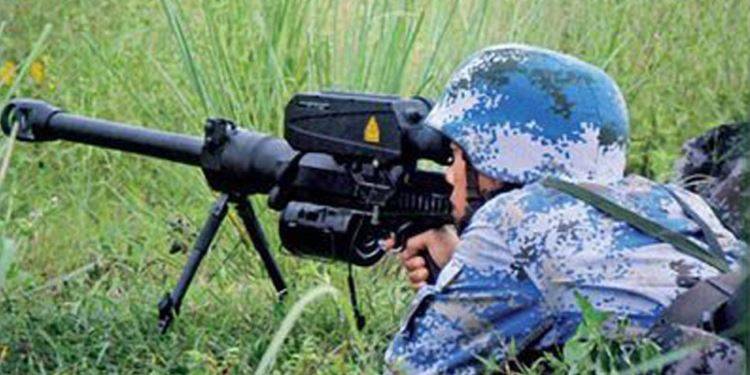
The QLU-11 "sniper" grenade launcher is equipped with a standard electronic-optical sight with a laser rangefinder and a ballistic computer, as well as 35 mm high-precision shots with fragmentation and cumulative grenades. Shooting is carried out with single shots, both from folding bipod and from a tripod machine. The mass of weapons on the bipod is 12,9 kg, on the machine - 23 kg. Ammunition is served from detachable drum stores with a capacity of 3 to 15 shots.
“Manual” 35-mm Chinese-made grenade launchers have a relatively low weight. But at the same time, they cannot compete in the density of fire with easel automatic grenade launchers of Soviet and American production. In this regard, on the basis of the QLZ-87 grenade launcher at the beginning of the 21st century, its easel version QLZ-04, adapted for tape power, was created. In the field, a grenade launcher is mounted on a tripod machine, but the designers provided for the possibility of placing it on military equipment and vehicles, patrol and landing boats, as well as helicopters.
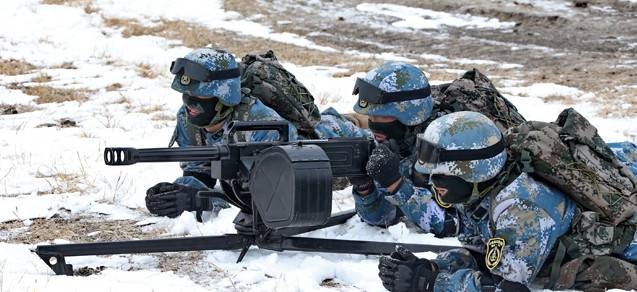
The grenade launcher mass on the machine without an ammunition box is 24 kg. Ammunition is supplied with weapons from bulk metal tape. The standard capacity of a tape placed in a removable box is 30 shots. Rate of fire: 350-400 rds / min. Fire is conducted in short bursts or single shots. In terms of firing range and armor penetration, the 35-mm QLZ-04 grenade launcher does not differ from the QLZ-87.
Concluding the review of modern Chinese anti-tank infantry weapons used by individual fighters, as well as as part of a squad, platoon and company, it can be stated that the People's Liberation Army of China is currently sufficiently saturated with modern anti-tank weapons that can fight the most protected armored by cars. In the final part of the cycle devoted to the anti-tank weapons of the Chinese infantry, we will talk about portable and transportable anti-tank missile systems available in the PLA.
The ending should ...
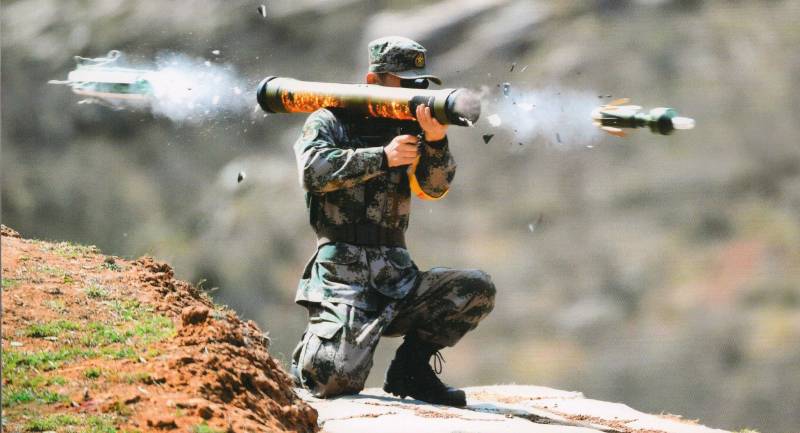
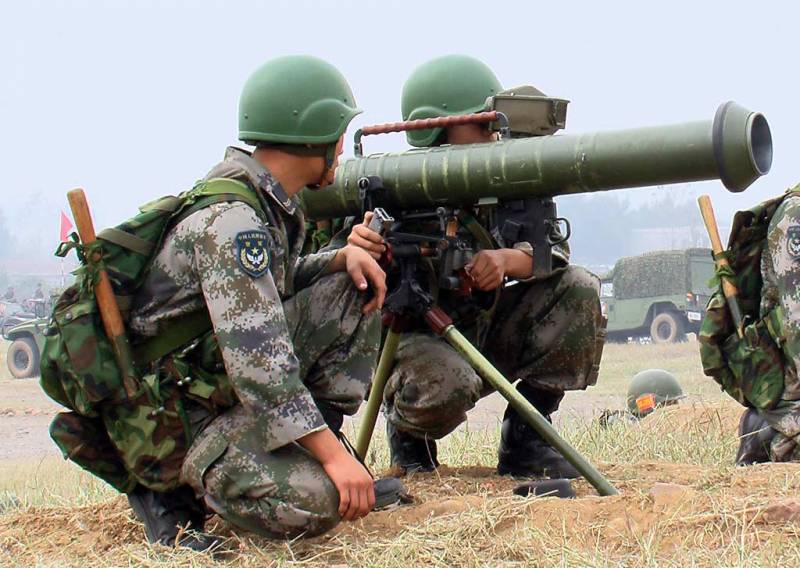
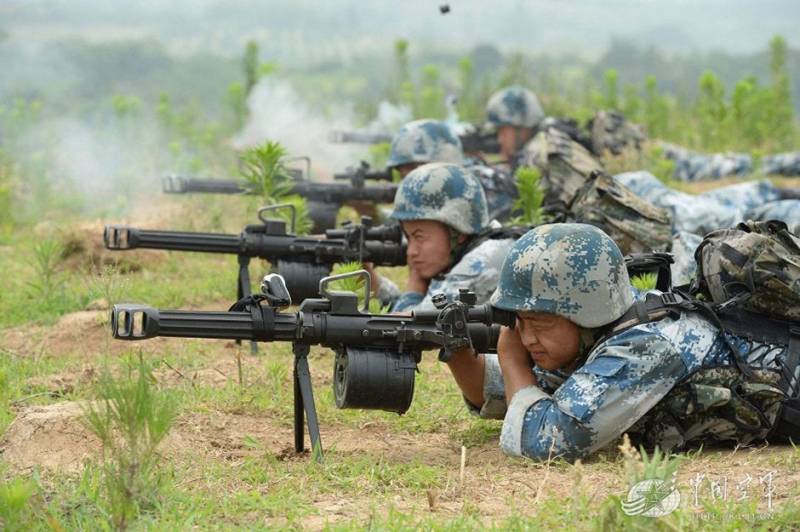
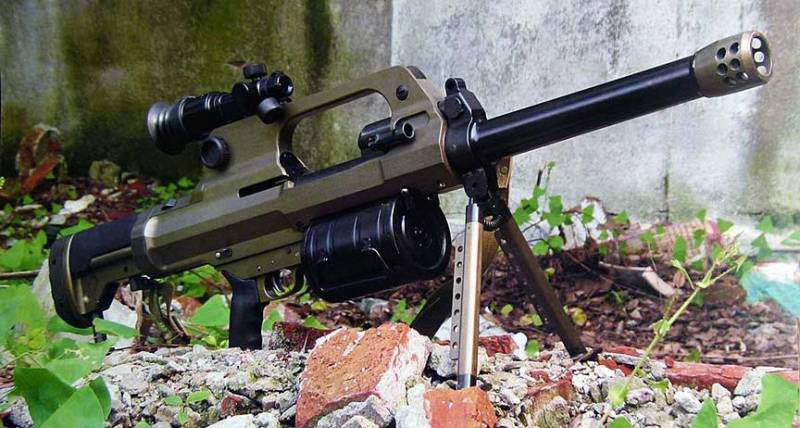
Information